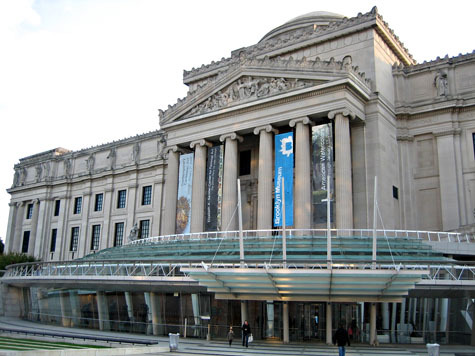
A lot of NY art folks have been tweeting of late about troubles (or perceived troubles) at the Brooklyn Museum. And as @cmonstah so aptly put it, today the Times published a selection of commentary on the topic "In which everyone and their mother offer the @brooklynmuseum some advice."
Though I'm no bit US or NYC museum-watcher, I thought the accompanying screeds—18 in all, from museum directors, artists and public administrators—had a lot of points to ponder for evaluating the success of any museum, including, ahem, Canadian ones.
Of course, because of my own views, I agreed with some of the comments more than others. Here's the ones that seemed to hit home for me, given my own, closer watching of access and measures-of-success issues at the AGO and the ROM, as well as getting a creeping feeling that a number of smaller local museums, like the Gardiner and the DX, are struggling with related problems:
MAXWELL L. ANDERSON, director of the Indianapolis Museum of Art :With a national average of 2 percent to 4 percent of art museum revenue coming from admissions, the distracting glitter of crowds is not as material to institutional health as most people assume. Instead of being evaluated for their contributions to research, preservation and education, art museums like the Brooklyn Museum are increasingly expected to be commercial attractions and economic engines.
The museum's future, like that of libraries, universities and other art museums beyond tourist meccas, lies in making a case for government, foundation and individual patronage by being a hotbed of creativity. Not by making a case for the box office.
Maxwell, you rock.
ANN PHILBIN, director of the Hammer Museum in Los Angeles :Attendance is simply one measure in a long list of priorities—some of which are very hard to quantify. For example, how does one measure the impact of showing a young artist for the first time and starting his or her career, or the ramifications of capturing the imaginations of young at-risk school groups?
Furthermore, how is attendance defined? At the Hammer we have begun to understand that our visitor numbers should not be limited to our own box office but might also include the hundreds of thousands of people aroun the world who log on to our Web site, hammer.ucla.edu, to view podcasts of our public programs, or the many thousands currently visiting the Charles Burchfield retrospective at the Whitney Museum of American Art, which the Hammer organized. Are these not all part of a measurable sphere of audience and influence?
Damn straight... I often feel like attendance is used as a measure of success just because it is easy to quantify.
ROCHELLE SLOVIN, director of the Museum of the Moving Image: What's bugging people about the Brooklyn Museum? Is there any good reason not to embrace First Saturdays? If international D.J.'s are O.K. for P.S.1 Contemporary Art Center, and string quartets are judged suitable for late nights at the Metropolitan Museum, then what exactly is the objection to hip-hop and salsa at the Brooklyn Museum? My advice to the Brooklyn Museum: Continue to take excellent care of your treasured collections, hang tough, and pile it on — more great exhibitions, more performances, more joyful noise.
Really love that point about "event bias" between different institutions.
KIKI SMITH, artist :Attendance is not necessarily a good measure of museum success. The quality of its collection, its administrative vision, the depth of its scholarly programming and its curatorial direction are. The nature of capitalism is dependent on growth, but it is not inherently in a museum's interest to expand.
Try telling that to the Vancouver Art Gallery, eh? Or if we could time-travel back, to the ROM and AGO and AGA, at least as a consideration.
Also, as an aside, Canada gets a shout out... though not in a good way!
GRAHAM W. J. BEAL, director of the Detroit Institute of Arts: Along with Brooklyn, the Museum of Fine Arts, Boston, and, increasingly, others, the Detroit Institute of Arts has been accused of "dumbing down" and "Disneyfication." I am, from time to time, described as leading the United States' most challenged institution, and it is true that we labor under many adverse conditions. But at least I do not have an art museum that is a world exemplar sitting across the river in Windsor, Ontario. Arnold is in an invidious position, and has tried to create a very different type of museum on the proverbial shoestring.
Still, Windsor semi-diss aside, I really recommend reading all the comments in the article. They show how many different ways there are of looking at and evaluating museums, as well as being passionate about them.
Image of the Brooklyn Museum from Obey
Thursday, August 5, 2010
Lessons from Brooklyn: What is a Museum For?
Subscribe to:
Post Comments (Atom)

2 comments:
Max Anderson is a former director/curator of AGO, famous for pushing block buster shows and pumping up attendance. I guess maybe he's working on a new theory now.
Good observation. I have so little schooling of people's institutional histories.
Post a Comment